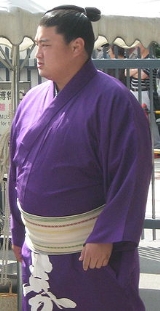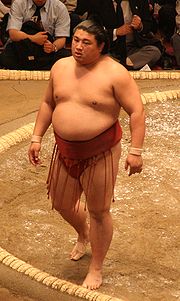
Yoshikaze Masatsugu
Encyclopedia
Yoshikaze Masatsugu is a sumo
wrestler from Saiki
, Oita Prefecture
, Japan
. A former amateur sumo champion, he turned professional in 2004, reaching the top division two years later. His highest rank has been maegashira 1. He has won two special prizes
for Fighting Spirit.
, and won the college equivalent of the yokozuna title in his third year. Because he wanted to wait until after his graduation from university before joining professional sumo, he missed out on the chance to enter at the level of the third makushita division. He joined Oguruma stable
and made his debut at maezumo level in January 2004. He was of course considerably older and more experienced than most of the competition there and quickly worked his way up the ranks, winning two tournament titles in the jonokuchi and sandanme divisions with perfect 7-0 records. He initially competed under his own surname of Onishi, but upon reaching the second highest jūryō division in July 2005 he changed his shikona
to Yoshikaze.
He was promoted to the top makuuchi
division in January 2006. It took him only 12 tournaments to make the top division from his professional debut, equal to the second fastest rise ever since the six tournaments per year system was introduced in 1958.
However, until January 2009 he did not manage to rise above the mid maegashira ranks and he has fallen back to the second division twice so far.
In the November 2007 tournament he defeated fan favourite Takamisakari with the rare but spectacular technique of utchari, or spin throw from the edge of the ring. However he was able to win only three other bouts in that tournament and fell to the bottom of the division. An 8-7 record in January 2008 kept him in makuuuchi.
 His best performance in the top division to date came in November 2008 when he won 11 bouts and was awarded his first sanshō
His best performance in the top division to date came in November 2008 when he won 11 bouts and was awarded his first sanshō
or special prize, for Fighting Spirit. He was promoted to a new high of maegashira 2 for the January 2009 tournament. Although he was not able to come through with a winning record his score of 6-9 was creditable, and he scored a memorable win over new ozeki Harumafuji on the opening day of the tournament. However, he gradually slipped back down the rankings with three more losing scores in the next three tournaments. The November 2009 tournament was one of his most successful, as he won nine of his first ten bouts before slowing down somewhat to finish on 10-5. In September 2010 he won his second Fighting Spirit prize, which was shared with his stablemate Takekaze, after producing a fine 11-4 score, having been 7-0. He followed up with a solid 8-7 record in November, which saw him return to maegashira 2 in January 2011.
are listed at the Sumo Association as tsuki/oshi, meaning he prefers pushing and thrusting moves as opposed to fighting on the opponent's mawashi
or belt. His most common winning techniques are oshidashi, the push out, and yorikiri, the force out.
Sumo
is a competitive full-contact sport where a wrestler attempts to force another wrestler out of a circular ring or to touch the ground with anything other than the soles of the feet. The sport originated in Japan, the only country where it is practiced professionally...
wrestler from Saiki
Saiki, Oita
is a city located in Ōita Prefecture, Japan.As of 2003, the former city had an estimated population of 49,183 and the density of 249.19 persons per km²...
, Oita Prefecture
Oita Prefecture
is a prefecture of Japan on Kyūshū Island. The prefectural capital is the city of Ōita.- History :Around the 6th century Kyushu consisted of four regions: Tsukushi-no-kuni 筑紫国, Hi-no-kuni 肥国, and Toyo no kuni...
, Japan
Japan
Japan is an island nation in East Asia. Located in the Pacific Ocean, it lies to the east of the Sea of Japan, China, North Korea, South Korea and Russia, stretching from the Sea of Okhotsk in the north to the East China Sea and Taiwan in the south...
. A former amateur sumo champion, he turned professional in 2004, reaching the top division two years later. His highest rank has been maegashira 1. He has won two special prizes
Sansho (Sumo)
Sanshō are the three special prizes awarded to top division sumo wrestlers for exceptional performance during a sumo honbasho or tournament. The prizes were first awarded in November 1947.-Criteria:...
for Fighting Spirit.
Career
Yoshikaze was an amateur sumo champion at Nihon Taiiku UniversityNippon Sport Science University
is a private university with campuses in Setagaya, Tokyo and Aoba-ku, Yokohama. The precursor of the school was founded 1893, and it was chartered as a university in 1949...
, and won the college equivalent of the yokozuna title in his third year. Because he wanted to wait until after his graduation from university before joining professional sumo, he missed out on the chance to enter at the level of the third makushita division. He joined Oguruma stable
Oguruma Stable
is a stable of sumo wrestlers, one of the Nishonoseki group of stables. In its modern form it dates from 1987 when it was founded by Kotokaze, a former Sadogatake stable wrestler. He gives all his new recruits shikona with the suffix "kaze" , taken from his own fighting name. The first wrestler...
and made his debut at maezumo level in January 2004. He was of course considerably older and more experienced than most of the competition there and quickly worked his way up the ranks, winning two tournament titles in the jonokuchi and sandanme divisions with perfect 7-0 records. He initially competed under his own surname of Onishi, but upon reaching the second highest jūryō division in July 2005 he changed his shikona
Shikona
A shikona is a sumo wrestler's ring name.As with standard Japanese names, a shikona consists of a 'surname' and a 'given' name, and the full name is written surname first. However, the given name is rarely used outside formal or ceremonial occasions. Thus, the former yokozuna Asashōryū Akinori is...
to Yoshikaze.
He was promoted to the top makuuchi
Makuuchi
or is the top division of professional sumo. Its size is fixed at 42 wrestlers , ordered into five ranks according to their ability as defined by their performance in previous tournaments....
division in January 2006. It took him only 12 tournaments to make the top division from his professional debut, equal to the second fastest rise ever since the six tournaments per year system was introduced in 1958.
However, until January 2009 he did not manage to rise above the mid maegashira ranks and he has fallen back to the second division twice so far.
In the November 2007 tournament he defeated fan favourite Takamisakari with the rare but spectacular technique of utchari, or spin throw from the edge of the ring. However he was able to win only three other bouts in that tournament and fell to the bottom of the division. An 8-7 record in January 2008 kept him in makuuuchi.

Sansho (Sumo)
Sanshō are the three special prizes awarded to top division sumo wrestlers for exceptional performance during a sumo honbasho or tournament. The prizes were first awarded in November 1947.-Criteria:...
or special prize, for Fighting Spirit. He was promoted to a new high of maegashira 2 for the January 2009 tournament. Although he was not able to come through with a winning record his score of 6-9 was creditable, and he scored a memorable win over new ozeki Harumafuji on the opening day of the tournament. However, he gradually slipped back down the rankings with three more losing scores in the next three tournaments. The November 2009 tournament was one of his most successful, as he won nine of his first ten bouts before slowing down somewhat to finish on 10-5. In September 2010 he won his second Fighting Spirit prize, which was shared with his stablemate Takekaze, after producing a fine 11-4 score, having been 7-0. He followed up with a solid 8-7 record in November, which saw him return to maegashira 2 in January 2011.
Fighting style
Yoshikaze's favourite techniquesKimarite
Kimarite are winning techniques in a sumo bout. For each bout in a Grand Sumo tournament , a sumo referee, or gyoji, will decide and announce the type of kimarite used by the winner...
are listed at the Sumo Association as tsuki/oshi, meaning he prefers pushing and thrusting moves as opposed to fighting on the opponent's mawashi
Mawashi
In sumo, a mawashi is the belt that the rikishi wears during training or in competition. Upper ranked professional wrestlers wear a keshō-mawashi as part of the ring entry ceremony or dohyo-iri.-Mawashi:...
or belt. His most common winning techniques are oshidashi, the push out, and yorikiri, the force out.

